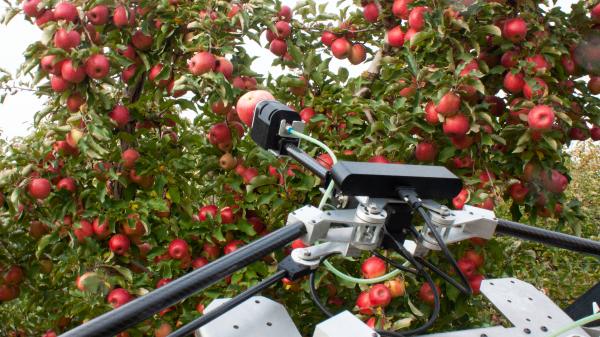Courtesy Ripe Robotics
It was once felt that robots were too heavy-handed and imprecise to be of benefit to packers and shippers. That was generations ago.
Now, almost all packaging is done at least partially by machine, and the number of packers and shippers who utilize mechanical means to send their products to market has grown every year for decades.
Sales of packing machinery grew by over 10 percent from 2021 to 2022, and experts see no change in the upward trend anytime soon.
Robotics plays a big part in this trend. According to a survey by the Robotic Industries Association, packers and shippers who use robots to put together consumer packaged goods (CPGs)—once part of a rarefied circle—now make up nearly half the industry, with 49.5 percent of packers using robotics.
One of the major advantages of using robotics technology, explains Hunter Jay, CEO of Australia-based Ripe Robotics, is that it narrows the lines between packers and growers and brings them closer together, creating efficiencies throughout the supply chain.
Jay sees great potential in the data robots can gather. “We take a picture of every piece of fruit picked, and later will do deeper analysis. It’s kind of like having a packing shed in the field.”
This allows users to calculate the size and quality of picked product directly from bins, allowing the packing sheds to set up lines to optimize what’s being delivered. The analysis can also determine how long a bin can be stored, letting shippers save on cold storage costs.
Robotic imaging of fruit and trees leading up to the harvest is a critical part of process improvement, as it boosts multiple lines of efficiency.
“[Packers] often do this already, but when they get it wrong, they end up with empty lines of one size fruit and overflowing lines of another,” explains Jay.
“Once you have enough robots, you can use the data coming from all of them to predict how large the yield will be across the whole region, for each variety. This will let everybody know roughly how much fruit will be coming down the line each week more accurately than current counts.”
The holy grail of robotics implementation for shippers—self-piloted equipment operated by artificial intelligence (AI)—has so far proven elusive.
But the industry came one step closer in May of last year when robotics pioneer Gideon debuted “Trey,” its fully autonomous forklift robot that can load or unload a truck entirely on its own, resulting in an increase in time efficiency of up to 80 percent.
This is an excerpt from the Applied Technology department in the March/April 2023 issue of Produce Blueprints Magazine. Click here to read the whole issue.
It was once felt that robots were too heavy-handed and imprecise to be of benefit to packers and shippers. That was generations ago.
Now, almost all packaging is done at least partially by machine, and the number of packers and shippers who utilize mechanical means to send their products to market has grown every year for decades.
Sales of packing machinery grew by over 10 percent from 2021 to 2022, and experts see no change in the upward trend anytime soon.
Robotics plays a big part in this trend. According to a survey by the Robotic Industries Association, packers and shippers who use robots to put together consumer packaged goods (CPGs)—once part of a rarefied circle—now make up nearly half the industry, with 49.5 percent of packers using robotics.
One of the major advantages of using robotics technology, explains Hunter Jay, CEO of Australia-based Ripe Robotics, is that it narrows the lines between packers and growers and brings them closer together, creating efficiencies throughout the supply chain.
Jay sees great potential in the data robots can gather. “We take a picture of every piece of fruit picked, and later will do deeper analysis. It’s kind of like having a packing shed in the field.”
This allows users to calculate the size and quality of picked product directly from bins, allowing the packing sheds to set up lines to optimize what’s being delivered. The analysis can also determine how long a bin can be stored, letting shippers save on cold storage costs.
Robotic imaging of fruit and trees leading up to the harvest is a critical part of process improvement, as it boosts multiple lines of efficiency.
“[Packers] often do this already, but when they get it wrong, they end up with empty lines of one size fruit and overflowing lines of another,” explains Jay.
“Once you have enough robots, you can use the data coming from all of them to predict how large the yield will be across the whole region, for each variety. This will let everybody know roughly how much fruit will be coming down the line each week more accurately than current counts.”
The holy grail of robotics implementation for shippers—self-piloted equipment operated by artificial intelligence (AI)—has so far proven elusive.
But the industry came one step closer in May of last year when robotics pioneer Gideon debuted “Trey,” its fully autonomous forklift robot that can load or unload a truck entirely on its own, resulting in an increase in time efficiency of up to 80 percent.
This is an excerpt from the Applied Technology department in the March/April 2023 issue of Produce Blueprints Magazine. Click here to read the whole issue.



